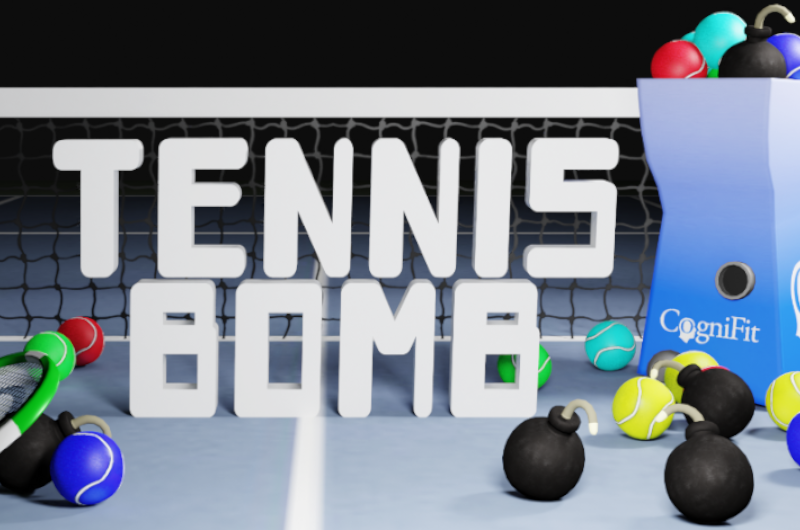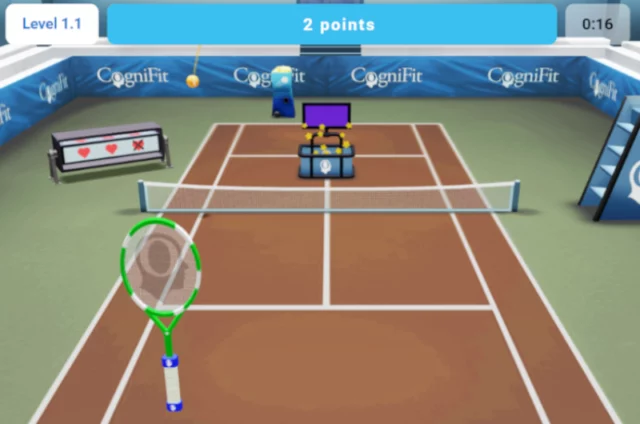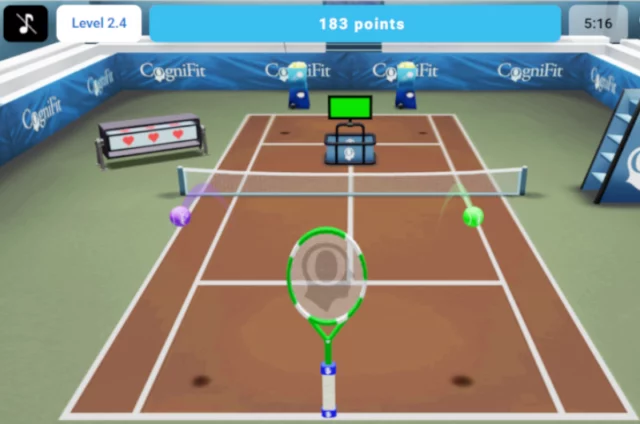
Tennis Bomb – Dodge & Hit for Brain Health
We’re back with another game review, and this time it’s Tennis Bomb! This colorful game isn’t just fun to play, it’s going to stimulate your Hand-eye Coordination, Response Time, and Visual Perception.
Let’s take a closer look at how you play and how each of these cognitive functions is vital to exercise.
How To Play Tennis Bomb
The premise might seem simple – just hit the corresponding tennis balls with the digital racquet. However, there’s so much more to this game than meets the eye.
First, you’ll go through a simple tutorial that explains the basics. On the other side of the court is a colored rectangle. And, using your mouse to move around your side of the court, hit the same-colored balls back into the box. So, if the rectangle is green, you only hit the green balls and avoid the rest.
However, if you miss one, you’ll lose one of your three lives/hearts. And if all three are gone, the round is over.

Also, once in a while, you might see a coin or a heart head your way. The coin gives you more points and the heart will heal one of your three lives. But what about the name of the game? Where are the bombs? Well, those appear even at the lowest levels. If you accidentally make contact with one, it will crack your racquet. The second bomb will break it.
NOTE: Don’t worry about “aiming” to get the balls into the box. All you have to do is make contact and the ball will automatically go into the box.
It’s also important to remember that you don’t have to stay at the very back of your side of the court. Your racquet can move in any direction. This becomes important at higher levels. Because not only do things speed up, but you’ll also have two or three color balls to keep track of (along with avoiding bombs and grabbing hearts or coins).
Tennis Bomb and The Brain
As mentioned before, there are three cognitive functions that this game will target. Let’s take a look at each one.
Hand-Eye Coordination
We tend to think of hand-eye coordination as something for gamers or sports players. But everyone uses this on a daily basis. We use it when we write/type, unlock a door, drive, etc.
Our eyes send visual information to the brain. It then processes it and tells our hands what to do. The interesting thing is, even if someone’s eyes are great, they can still have coordination problems.
The tie-in to Tennis Bomb is simple. You have to keep an eye on the balls and then use your hands to move the mouse to the correct position.

Response Time
Also called “Reaction Time”, this cognitive ability handles how long it takes for you to see something and then react to it. We use it in everything from driving to doing what is necessary during an emergency. This time can be influenced by many things, such as…
- Complexity – The more complex it is, the longer it will take for your brain to process the information.
- Familiarity – The more someone has dealt with the stimulus before, the lower the reaction time. The same thing goes if you’re expecting it.
- State of the organism – If someone is tired, old, has eaten too much, is on drugs, etc., that can affect the time as well.
- Type of Stimulation – Audio is translated faster than visual, etc.
Blindness, hearing problems, diseases like Alzheimer’s or Parkinson’s, ADHD, concussions, etc., all are examples of things that can negatively affect reaction times.
When you play Tennis Bomb, you need to use this ability to see the balls, bombs, coins, or hearts, and react – whether hitting or moving away.
Visual Perception
This one might sound complicated (as with all things related to the brain). However, if we boil it down, it’s not that hard to understand.
Basically, whatever we see becomes visual information our brain must process to recognize or understand. This can include size, shape, lighting, position, color, dimensions, movement, measurements, names, and even our personal relationship with the object.
Our brains do this all day and in milliseconds. We need it to recognize things like language or loved ones. However, some rely on this ability even more – like driving, creating art, security jobs, etc.
Interesting Fact – Visual agnosia is the inability to recognize learned objects, even though your sight is still intact.
In Tennis Bomb, we must use Visual Perception to know what to hit (like balls vs. coins) and what to avoid (like bombs).
Tennis Bomb Conclusion
Not all CogniFit games have the “restore lives” function. So, if you’re someone who likes more gamification or just wants the chance to stay in the level longer and advance to harder difficulties, then this is the game for you!
Also, you don’t need to play any of these games for long. A normal brain training regime only needs three sessions a week and 20 minutes per session!












